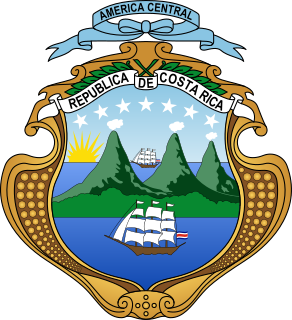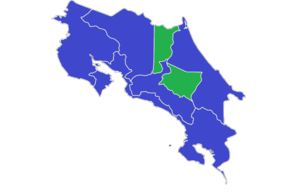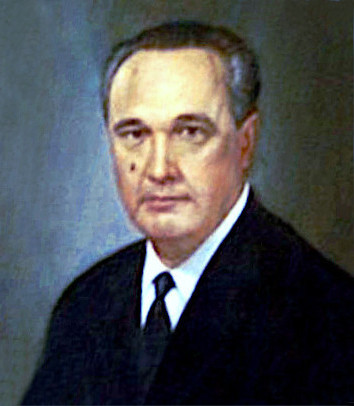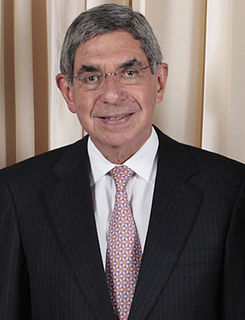| ||||||||||||||||||||
| Turnout | 81.3% | |||||||||||||||||||
| ||||||||||||||||||||
In green provinces won by Monge, in blue Carazo | ||||||||||||||||||||
| ||||||||||||||||||||
 |
|---|
| This article is part of a series on the politics and government of Costa Rica |
Legislature |
|
General elections were held in Costa Rica on 5 February 1978. [1] Rodrigo Carazo Odio of the Unity Coalition won the presidential election, whilst his party also won the parliamentary election. Voter turnout was 81%. [2]

Costa Rica, officially the Republic of Costa Rica, is a country in Central America, bordered by Nicaragua to the north, the Caribbean Sea to the northeast, Panama to the southeast, the Pacific Ocean to the southwest, and Ecuador to the south of Cocos Island. It has a population of around 5 million in a land area of 51,060 square kilometers. An estimated 333,980 people live in the capital and largest city, San José with around 2 million people in the surrounding metropolitan area.

Rodrigo José Ramón Francisco de Jesús Carazo Odio served as President of Costa Rica from 8 May 1978 to 8 May 1982.
The Unity Coalition was a Costa Rican political coalition of right-wing opposition parties made in the 70s and oppose to the then ruling centre-left National Liberation Party. Four parties made the coalition; Democratic Renewal, Christian Democrats, People’s Union and Republican Calderonista. After a primary election from which Rodrigo Carazo Odio was victorious the coalition presented him as candidate winning the 1978 elections. Eventually the Coalition merged forming the Social Christian Unity Party in 1983.
Contents
Carazo, a former congressman and former member of the National Liberation Party (probably Costa Rica’s main political force), left the party several years before and created his own: Democratic Renovation, but a deeply split opposition on the 1974 election caused PLN’s easy victory. With that in mind, main leaders of the non-Marxist opposition started talks in order to present a unified candidature. [3] [4]

The National Liberation Party, nicknamed the verdiblancos, is a political party in Costa Rica. The party is a member of the Socialist International.
Eventually these talks came through and the main parties in the opposition at the right of the government achieved an agreement; going into a primary election to choose the common nominee. Rodrigo Carazo faced wealthy industrial Miguel Barzuna winning by small margin. Even when some leaders left the coalition after this (most notably Jorge Gonzalez Marten from the National Independent Party and former president Mario Echandi) most of the leadership remained united. [5] The Unity Coalition was created out of the joining of four parties: Carazo’s Democratic Renovation, former president José Joaquín Trejos’ People’s Union, Rafael Calderón Fournier (son of Calderonist leader Rafael Calderón Guardia) Republican Party and Dr. Jorge Arturo Monge’s Christian Democratic Party (the smallest one of the coalition but the most ideologically coherent). [6]

The President of Costa Rica is the head of state and head of government of Costa Rica. The President is currently elected in direct elections for a period of four years, which is not immediately renewable. Two Vice presidents are elected in the same ticket with the president. The president appoints the Council of Ministers. Due to the abolition of the military of Costa Rica in 1948, the president is not a Commander-in-chief, unlike the norm in most other countries, although the Constitution does describe him as commander in chief of the civil defense public forces.

Rafael Ángel Calderón Fournier served as President of Costa Rica from 1990 to 1994. He was the presidential candidate of the Social Christian Unity Party for the national elections held in February 2010, but resigned his candidacy on 5 October 2009, when he was sentenced to five years in prison for two counts of corruption.
The Left also made a coalition; the three main far-left parties at the Left of PLN; Popular Vanguard, Costa Rican Socialist Party and Revolutionary People’s Movement made the United People coalition, [7] nominating former PLN member and doctor Rodrigo Gutierrez. Gutierrez had no possibilities to be president but the coalition did help the Left having a higher voting than usual and a large group in Congress. For many historians this election marks the beginning of Costa Rica's two-party system. [8]

The People's Vanguard Party, or Popular Vanguard Party is a communist party in Costa Rica. PVP was founded in 1931 as the Workers and Farmers Party, but was soon renamed to the Communist Party of Costa Rica.

United People was a left-wing political alliance, registered as a political party, in Costa Rica.
A two-party system is a party system where two major political parties dominate the government. One of the two parties typically holds a majority in the legislature and is usually referred to as the majority or governing party while the other is the minority or opposition party. Around the world, the term has different senses. For example, in the United States, Jamaica, and Malta, the sense of two-party system describes an arrangement in which all or nearly all elected officials belong to one of the only two major parties, and third parties rarely win any seats in the legislature. In such arrangements, two-party systems are thought to result from various factors like winner-takes-all election rules. In such systems, while chances for third-party candidates winning election to major national office are remote, it is possible for groups within the larger parties, or in opposition to one or both of them, to exert influence on the two major parties. In contrast, in the United Kingdom and Australia and in other parliamentary systems and elsewhere, the term two-party system is sometimes used to indicate an arrangement in which two major parties dominate elections but in which there are viable third parties which do win seats in the legislature, and in which the two major parties exert proportionately greater influence than their percentage of votes would suggest.















